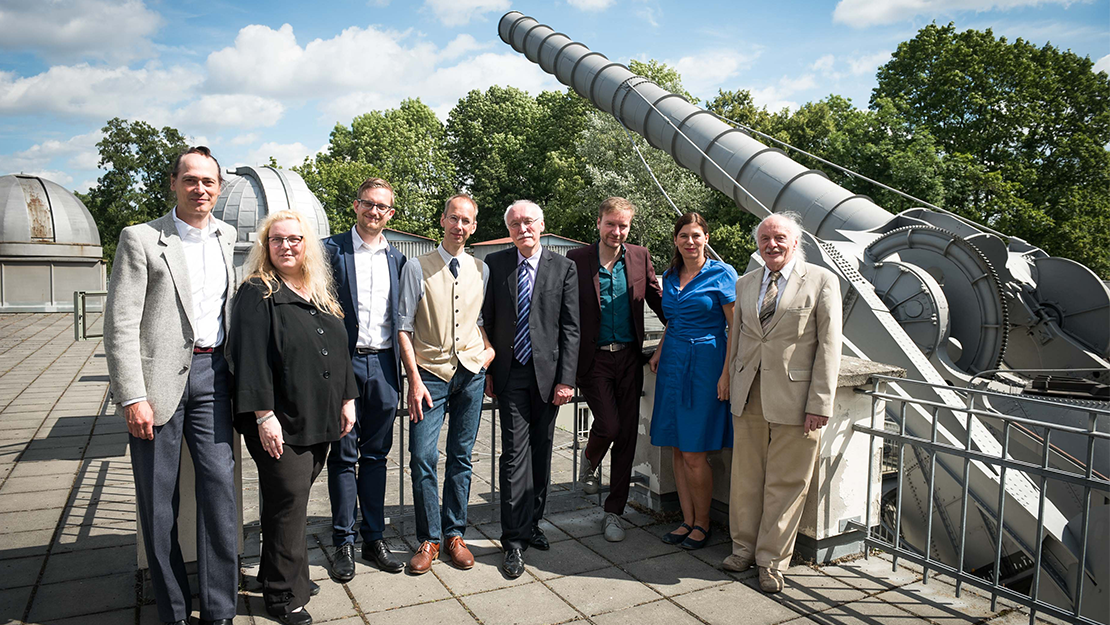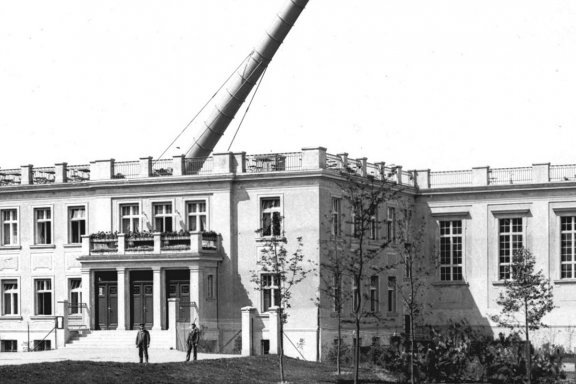
History
Archenhold-Observatory
History of the Archenhold-Observatory
1896 | The »Sky cannon« as an attraction at the Berlin Trade Fair
At the Berlin Trade Fair in 1896, a large wooden building is home to a very special exhibit: a 21-metre-long giant telescope – the longest refractor in the world to this day. It was built with the help of donations and on the initiative of Friedrich Simon Archenhold. Although the »sky cannon« is not fully functional until September, it arouses great interest among visitors. When, after the end of the exhibition, there is no money to dismantle the telescope in accordance with the contract, the Berlin magistrate finally gives permission for the telescope to remain in Treptower Park »until further notice«. Thus the observatory is effectively founded. It is run by the »Verein Treptow-Sternwarte e.V.«. The founder of the observatory, Friedrich Simon Archenhold, becomes chairman of the association and its first director.
In the provisional wooden building, the observatory starts its operation and quickly enjoys great popularity among the residents of Berlin. With the telescope, a small exhibition and library as well as a lecture room, it makes an important contribution to popular education in Berlin.
1908 – 1909 | A new building for the observatory
After only a few years, the new observatory has established itself as a permanent Berlin institution. The wooden building, intended only for one summer, proves to be an unsuitable domicile in the long term. For this reason, the royal architects Konrad Reimer and Friedrich Körte draw up a design for the new building of the Treptow observatory in the classicist style, which they officially submit to the Berlin magistrate on 28 February 1908. In the meantime, director Friedrich Simon Archenhold tries to raise funds for the construction. Finally, on 17 May 1908, the foundation stone for the new observatory building is laid. After almost a year of construction, the new building is inaugurated on 4 April 1909, in glorious spring weather. In the following years, Archenhold organises lively events in the observatory and establishes a versatile programme. School classes can now visit the observatory free of charge. Archenhold is also enthusiastic about new technical possibilities and begins to make films about astronomy and astronomical events.
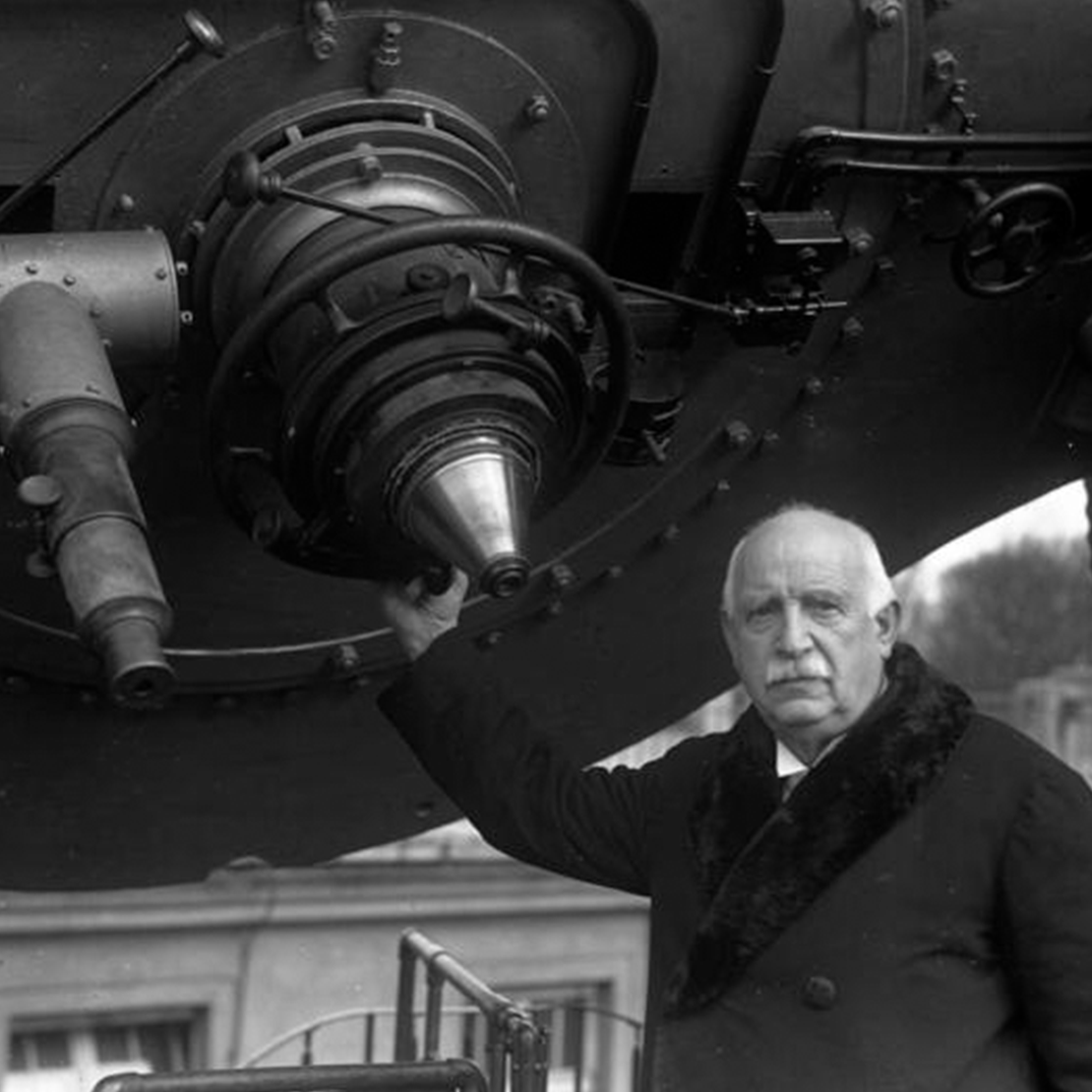
1915 | Albert Einstein gives the first lecture in Berlin on the theory of relativity at the Treptow Observatory
On 2 June 1915, Albert Einstein gives his first (of four) public lectures in Berlin on the theory of relativity in the large lecture hall of the Treptow Observatory. Between then and 1933, around 30 articles on Einstein's theory of relativity and its consequences for astronomy appear in the journal »Das Weltall«, edited by Friedrich Simon Archenhold. On the occasion of Einstein's 100th birthday on 15 March 1979, the hall was renamed »Einstein Hall«. Since then, a memorial plaque has commemorated the lecture of the famous physicist.
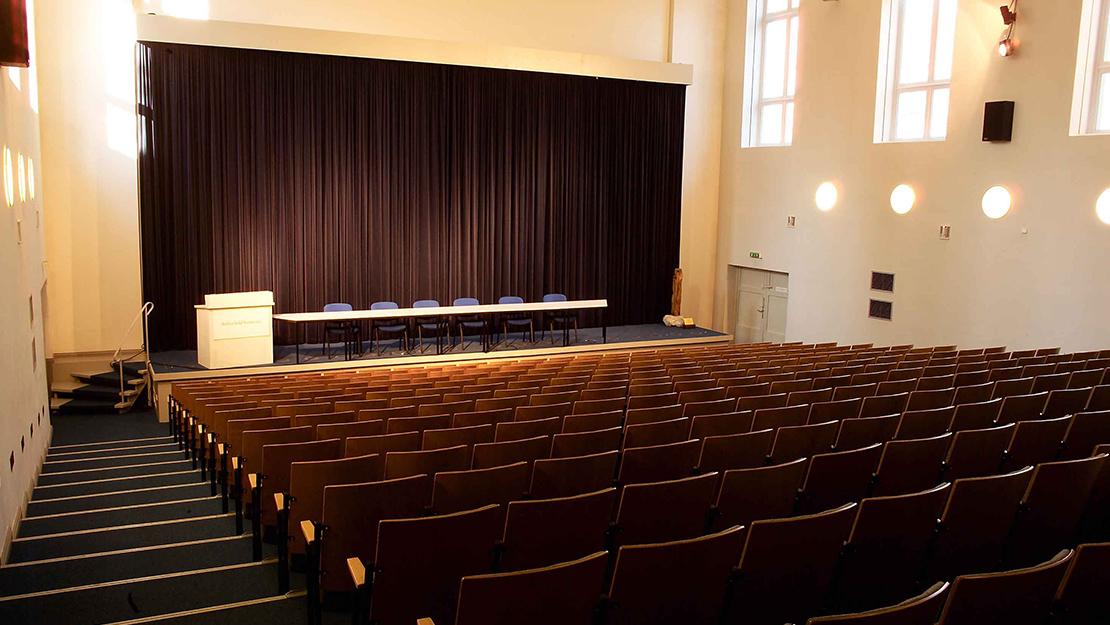
1931 – 1945 | A new generation and National Socialism
In 1931, at the age of 70, Friedrich Simon Archenhold hands over the management of the observatory to his son Günter Archenhold, who among other things founds the Astronomische Arbeitsgemeinschaften (Working Communities for Astronomy).
With the seizure of power by the National Socialists in 1933, the discrimination and ousting of the Jewish Archenhold family from the observatory begins. In 1936, Günter Archenhold is finally forced out of office, the observatory is taken over by the city of Berlin without compensation and placed under the authority of the school administration. The observatory is temporarily closed for renovation. From 1937 to 1945, Richard Sommer takes over the scientific management and continues the Astronomische Arbeitsgemeinschaften.
Friedrich Simon Archenhold dies in Berlin on 14 October 1939. His wife Alice and his daughter Hilde perish in the Theresienstadt concentration camp. His sons Günter and Horst Archenhold emigrate to England.
During the Second World War, the observatory and the giant telescope are damaged during air raids.
1945 | New beginnings after the war
After the war, the magistrate of Berlin appoints Edgar Mädlow as provisional director of the observatory, who has been a member of the Astronomische Arbeitsgemeinschaft since 1937 and is also involved in the public service of the observatory. Mädlow successfully advocates the resumption of observatory operations and a provisional repair of the large refractor. As early as on 9 July 1945, the partial solar eclipse can be observed from the roof of the observatory with the great telescope. Mädlow subsequently secures the remaining teaching material from the planetarium in the zoo and transfers two telescopes and the library from the abandoned Urania observatory to Treptow.
On 17 August 1946, the 50th anniversary of the observatory is celebrated. In a ceremony, the institution receives the name »Archenhold-Sternwarte«.
1948 – 1959 | Observatory is rebuilt – Large refractor is decommissioned
On 1 June 1948, Diedrich Wattenberg is appointed as the new director. He has been associated with the observatory since 1928, among other things as an author for the magazine »Das Weltall« . Wattenberg is in charge of the reconstruction of the building damaged during the war. For technical reasons, the large refractor had to be shut down in 1958. The rail system of the sliding roof and the railings around the instrument are so rusted that a safe operation has become impossible. In 1959, the first Zeiss-Kleinplanetarium (type ZKP I) of the GDR is put into operation in an annex of the Archenhold-Sternwarte. In the same year, astronomy lessons are introduced in the GDR: in year 11 (10. Klasse), there is now one hour of celestial science per week. The first textbook for astronomy lessons is written by the observatory director Diedrich Wattenberg.
1960s | New instruments
From 1960 to 1962, an area northwest of the observatory is developed as an open-air site. The newly constructed buildings house modern equipment from VEB Carl Zeiss Jena, also as a replacement for the no longer functioning giant telescope. These include a 500 mm Cassegrain reflector telescope, a 150 mm Coudé refractor and a 300 mm Jensch coelostat. Together with a 200 mm AS lens, the coelostat is the main piece optical equipment in the Solar Physics Cabinet, which is completed in 1965.
1970s | Change of directors and renovation of the Great Refractor
In 1970, the research department for the history of astronomy is founded at the observatory. Its first director is Dr. Dieter B. Herrmann (* 3. Januar 1939; † 25. November 2021), who succeeds Wattenberg as director in November 1976. After he took office, the restoration of the Great Refractor, which has been a protected monument since 1968, began in 1977. All of the original essential parts of the instrument (mechanics, optics) remain.
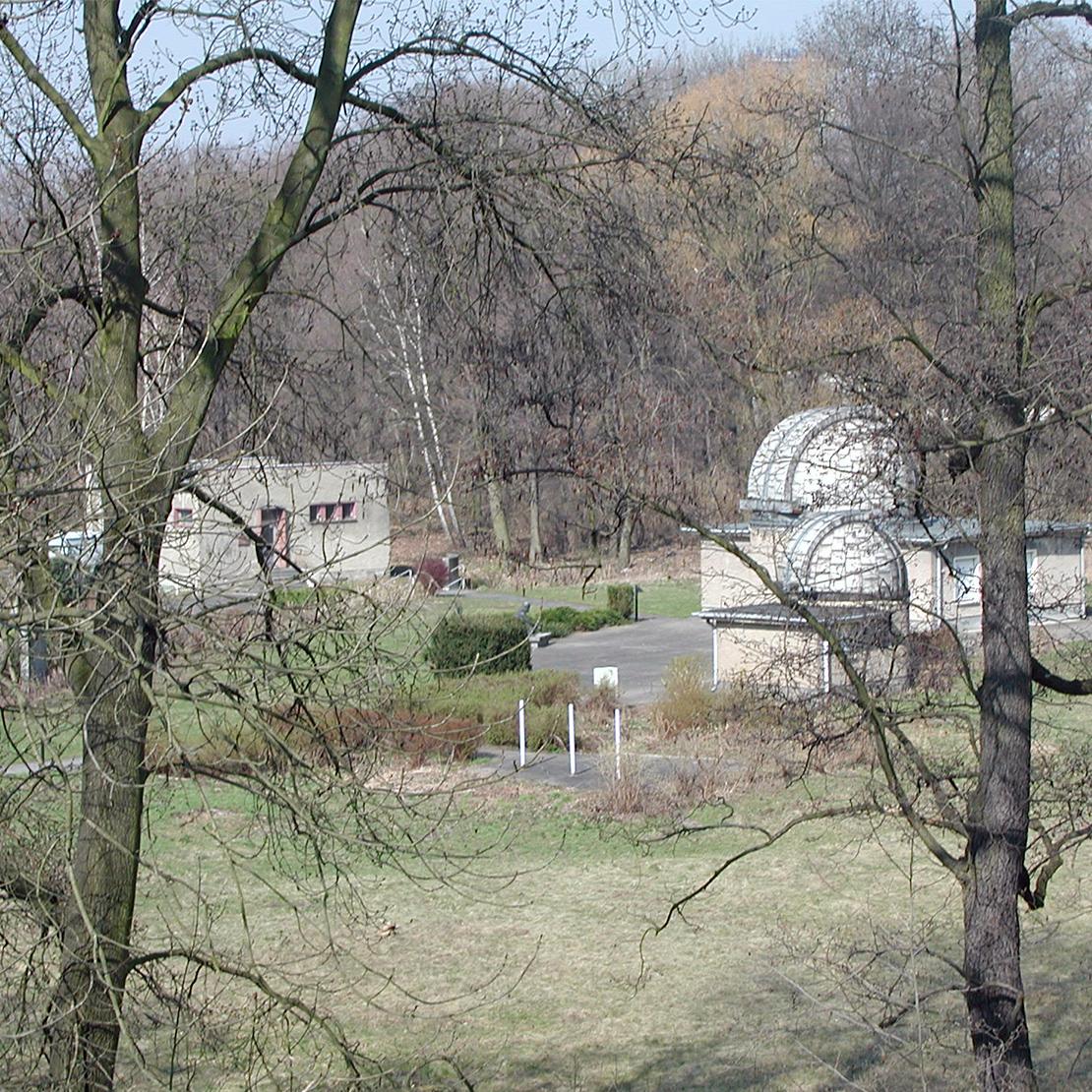
1980s | Modernisation and new construction of the Zeiss-Großplanetarium in Prenzlauer Berg
In 1982, the planetarium is modernised and the projector is replaced by the new Zeiss-Kleinplanetarium type ZKP 2. Now the complete southern night sky and the course of the planets can also be displayed under the starry sky. The eight-metre-diameter dome now offers a larger seating capacity of 90 (previously there were 60).
In 1983, for the first time in 25 years, the giant telescope is fully functional and ready for operation.
Dieter B. Herrmann distinguishes the Archenhold-Sternwarte in public by the development of a repertory programme and scientifically by an active research activity in the field of the history of astronomy. As far as it is possible under the conditions of the GDR, contacts are established with astronomy historians in other countries, cooperation in the International Astronomical Union (IAU) is strived for and regular colloquia on topics of the history of astronomy are held.
On the occasion of Berlin's 750th anniversary, the Zeiss-Großplanetarium opens in Prenzlauer Berg on 9 October 1987. It forms a joint facility with the Archenhold-Sternwarte.
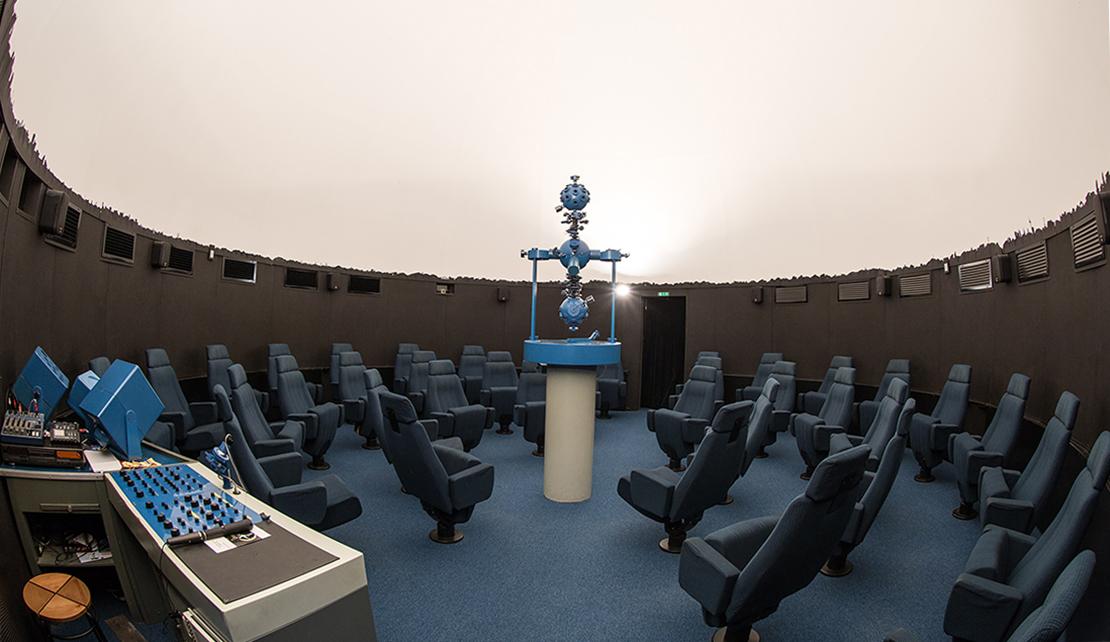
1989 – 1990 | Turbulent times
In 1989, repairs to the giant telescope become necessary again. The outer sheet metal tube is partially rusted through and must be replaced step by step. It is manufactured and assembled in an elaborate process according to a historical model. The repairs last until 1990, when the telescope is ready for use again.
With the reunification of the two German states, a difficult transformation process begins for the Archenhold-Sternwarte and the Zeiss-Großplanetarium: visitor numbers fall, there are massive staff cutbacks, and the entire institution is threatened with liquidation. Great efforts are made to preserve the existence and working capacity of both institutions.
1994 – 1996 | Renovation of the Archenhold-Sternwarte
In 1994, the Senate Department for Building, Housing and Transport begins the comprehensive renovation of the observatory, which is a listed building. For example, the heating and ventilation systems as well as the entire electrical system are renewed, the roof structure of the west wing is completely rebuilt, and large parts of the building are replastered. On the occasion of the 100th anniversary of the founding of the observatory in 1996, essential renovation work is completed, and the observatory presents itself in a new look. Among the numerous guests of honour at the anniversary celebrations are many members of the Archenhold family who travel from all over the world. On the occasion of the anniversary, Prof. Dr. Dieter. B. Herrmann publishes the commemorative publication »100 Years of the Archenhold-Sternwarte«, which documents the history of the observatory from the Empire to the reunited Germany.
2002 – 2016 | Stiftung Deutsches Technikmuseum Berlin (German Museum of Technology) and change of management
On 1 July 2002, the Archenhold-Sternwarte and the Zeiss-Großplanetarium become part of the Stiftung Deutsches Technikmuseum Berlin and thus locations of the Museum of Technology in Berlin-Kreuzberg.
After almost 30 years of service, Dieter B. Herrmann (* 3. Januar 1939; † 25. November 2021) retires in 2004. From March 2005 to May 2006, Dr. Klaus Staubermann takes over the management of both institutions. From May 2006 to February 2009, Dietmar Fürst takes over the management of the Archenhold-Sternwarte and is succeeded by Dr. Felix Lühning from 2009-2019. Since 2019 Tim Florian Horn is director of the Archenhold-Sternwarte.
2016 | Founding of the Stiftung Planetarium Berlin
On 1 July 2016, the ceremony for the founding of the Stiftung Planetarium Berlin took place at the Archenhold-Sternwarte. Together with the Planetarium am Insulaner with Wilhelm-Foerster-Sternwarte and the Zeiss-Großplanetarium, it now forms a joint organisational institution under the direction of Tim Florian Horn. Under the umbrella of the new foundation, the Archenhold-Sternwarte is to be further developed into a modern astronomy and science museum.
